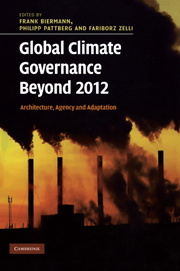Book contents
- Frontmatter
- Contents
- List of contributors
- Preface
- List of abbreviations
- 1 Global climate governance beyond 2012
- Part I Architecture
- Part II Agency
- Part III Adaptation
- 14 Global adaptation governance
- 15 Costs, benefits and interlinkages between adaptation and mitigation
- 16 Global adaptation governance
- 17 Global adaptation governance beyond 2012
- 18 Shaping future adaptation governance
- 19 Conclusions
- Index
- References
15 - Costs, benefits and interlinkages between adaptation and mitigation
Published online by Cambridge University Press: 05 July 2014
- Frontmatter
- Contents
- List of contributors
- Preface
- List of abbreviations
- 1 Global climate governance beyond 2012
- Part I Architecture
- Part II Agency
- Part III Adaptation
- 14 Global adaptation governance
- 15 Costs, benefits and interlinkages between adaptation and mitigation
- 16 Global adaptation governance
- 17 Global adaptation governance beyond 2012
- 18 Shaping future adaptation governance
- 19 Conclusions
- Index
- References
Summary
Introduction
The thirteenth Conference of the Parties to the United Nations Framework Convention on Climate Change in 2007 decided that developing countries should be compensated for adaptation costs to climate change through the Adaptation Fund (first draft decision of the third session of the conference of the parties serving as the meeting of the parties to the Kyoto Protocol). This shows that adaptation to climate change has become important in international climate negotiations. Today, adaptation is widely recognized as an equally important and complementary response to climate change mitigation (for example, Commission of the European Communities 2007; IPCC 2007a; Agrawala and Fankhauser 2008).
Still, relatively little information is available to support more integrated climate policies that focus on both mitigation and adaptation (Klein et al. 2005). In particular, in integrated assessment models that aim at supporting climate policy by analysing their economic and environmental consequences and formulating efficient responses, explicit consideration of adaptation is still in its infancy (Tol 2005; Wilbanks 2005; Agrawala et al. 2008).
This chapter tries to fill the gap in integrated assessment models by integrating adaptation and residual damage functions from AD-RICE (de Bruin et al. 2009) with the FAIR model (den Elzen and van Vuuren 2007; Hof et al. 2008). This version of the FAIR model (from now on called AD-FAIR) enables an analysis of the interactions between mitigation, emissions trading, adaptation and residual damages (that is, damages not avoided by adaptation measures) on a global as well as regional scale. Furthermore, adaptation is modelled explicitly as a policy variable, providing insights in the economic consequences of adaptation. This information is vital for effective adaptation governance.
- Type
- Chapter
- Information
- Global Climate Governance Beyond 2012Architecture, Agency and Adaptation, pp. 235 - 254Publisher: Cambridge University PressPrint publication year: 2010
References
- 1
- Cited by



